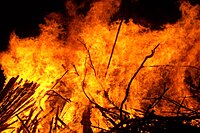
Photo from wikipedia
Abstract H2/air supersonic mixing layers were calculated with different splitter plates thickness. The accumulation of OH radicals between the most reactive and stoichiometric mixture fraction causes the corresponding change of… Click to show full abstract
Abstract H2/air supersonic mixing layers were calculated with different splitter plates thickness. The accumulation of OH radicals between the most reactive and stoichiometric mixture fraction causes the corresponding change of reactions. With the increase of plate thickness, flame surfaces tend to be more wrinkling. Especially in the initial developing stage, the distribution of temperature, scalar dissipation, Damkohler number and Takeno index is closely related to plate thickness. However in the developed stage, the distribution shows similarity. The symmetry of scalar dissipation rate built in the initial developing zone is broken in the developed stage, corresponding to the distribution about production terms of scalar variance [1]. Different from circulation and developed zone, premixed combustion take a more important part in the initial developing stage. Same as the change of flame curvature, autoignition effect dominating heat release increases first and decreases lately along streamwise direction.
Journal Title: Acta Astronautica
Year Published: 2020
Link to full text (if available)
Share on Social Media: Sign Up to like & get
recommendations!